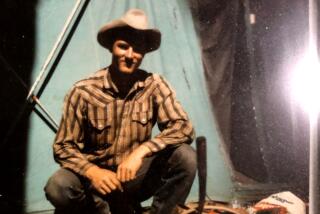A Man Who Follows His Mules
- Share via
Lofty accomplishments are all in a day’s work to Mark Drummond. As chancellor of the Los Angeles Community College District, Drummond prides himself most on helping create a $1.2-billion bond measure to upgrade the district’s aging classrooms and deteriorating buildings.
“The girls” are a close second.
That would be Donut, 10, Cinder, 6, and Arrow, 2, the mules who live on Drummond’s four-acre ranch in Norco. There’s also a donkey named Strawberry. Drummond breeds, trains and sells horses, too, but his heart belongs to the girls. (“I’ve never had a boy mule,” he says.)
And the girls like Drummond: His mules are standouts on the competition circuit. Cinder took first place in the Western Trail Course at the 2001 Los Angeles County Fair, though she fared less well at the Mule Days Celebration in Bishop this spring. “I gave her a bad cue during the pole-bending competition and she missed being one of the top 10 finalists by four-tenths of a second,” Drummond recalls. (Pole-bending, it seems, is a kind of slalom skiing event for mules.) However, Strawberry placed fourth in pole-bending and came in sixth in donkey pleasure-riding. “She’s only 2 and she was up against champions, so that’s pretty good,” says Drummond.
Mule mania set in for Drummond when he was growing up in Northern California. While spending time with his father, who used mules and horses to hunt and fish after a disabling logging accident, Drummond learned to care for the animals on the trail. He found he preferred horses for riding, but became better friends with the mules. “They were more devilish and conducive to building friendships, and they like to play tricks,” he says. “I played hide and seek with a mule once up in the Sierra Nevada.”
To review the zoology, a mule is the sterile offspring of a horse and a donkey. As Drummond puts it, each mule is its own family and its own family tree. Mule aficionados are something of a subculture even within the equestrian community, Drummond says. He estimates the U.S. mule population at about 300,000, compared to about 1.7 million horses, and notes that mules are used mainly for recreation, while some do farm work and others serve as pack animals for trail treks, firefighting and search-and-rescue missions.
As for that “stubborn as a mule” thing, Drummond insists it’s a canard born of the mule’s superior intelligence. “Anybody who knows animals knows that a mule is half again as smart as a horse,” he says. “Mules have the reputation of being stubborn, but it’s because they ask questions. They want to know why they are doing something. A horse reacts to fear, but a mule has a whole different perspective. He wants to know why, and if you don’t answer the questions for him, he plants his feet and says, ‘No, I’m not going to do it.’ It’s not obstinate, it’s a highly developed personality. The mule must think about it and decide what to do after its questions are answered.”
More to Read
Sign up for Essential California
The most important California stories and recommendations in your inbox every morning.
You may occasionally receive promotional content from the Los Angeles Times.











